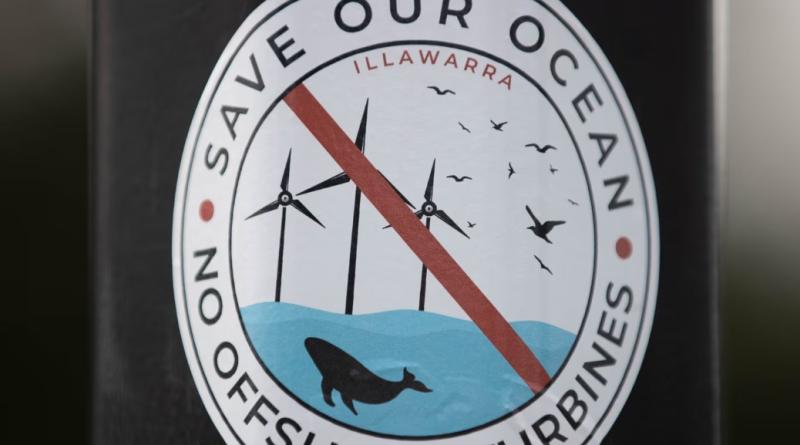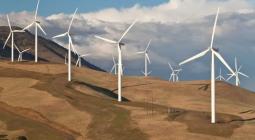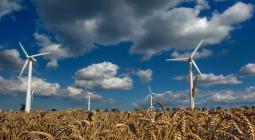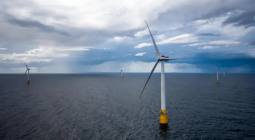How a false claim about wind turbines killing whales is spinning out of control in coastal Australia

Some pictures show a whale lifeless on a beach. In others, the whale is on fire, jumping from the ocean, as wind turbines loom behind it. The pictures are shocking – intentionally so. Recently they’ve appeared on posters and placards and in social media posts in New South Wales’ Hunter and Illawarra regions, as part of a growing campaign against an Albanese government plan to open offshore windfarms zones off the coast.
For weeks, an image of a beached whale with turbines in the background has appeared on a roadside billboard in Port Stephens, north of Newcastle, under the words “Stop Port Stephens Offshore Wind Farms”. After questions from Guardian Australia this week, the advertising company oOh!media added a note to the billboard saying it had been authorised by Troy Radford, the president of the Newcastle and Port Stephens Game Fish Club.
Asked about the ad, Radford said it had been paid for by members of the fishing community and acknowledged “we had someone design it for us”. “It needed to be high impact and visual, and that sums up the information that we’ve got at the time on the potential whale deaths,” he said.
But scientists are clear: the suggestion wind turbines kill whales is not backed by credible evidence.
Quentin Hanich, the editor-in-chief of the academic journal Marine Policy and professorial fellow at the University of Wollongong, spent this week debunking a fake article shared on social media that purported to be from his publication which claimed offshore wind projects in the Illawarra and Hunter would kill 400 whales a year.
The Facebook group took that post down but he worries about the nonexistent study’s broader impact.
“There’s been a whole bunch of continuing dialogue that suggests that windfarms kill whales without any actual evidence to demonstrate that that’s the case,” Hanich said.
This is part of the backdrop to the campaign opposing offshore windfarms in NSW, which has developed momentum in recent weeks, backed by locals, fishers, tourism operators, surfers and MPs from outside the region opposed to renewable energy development.
It has risen despite support from industry, unions, local MPs and councillors, the university and environment groups. Greenpeace and the Australian Conservation Foundation have stepped in seeking to counter concerns about whales.
Observers say it can be seen as part of the broader challenge to developments meant to move Australia from relying mostly on coal power to running nearly entirely on renewable energy. It is not what the government expected when the climate change and energy minister, Chris Bowen, last year outlined proposals for six offshore wind zones across the country, arguing Australia had “world-class offshore wind energy potential” and that “just one rotation of one offshore wind turbine provides as much energy as an average rooftop solar installation generates in one day”.
Arthur Rorris, the secretary of the South Coast Labour Council and a supporter of offshore wind developments, said there were grounds for people who support a rapid transition to clean energy to be concerned. “The Illawarra has been a sounding board for how to divide and turn communities against windfarms in Australia, and it has shown these strategies have worked.
“We will soon see this playing out across the country,” he said.
An opposition fanned by the Coalition
A consultation period for the first zone off Gippsland in Victoria was declared with relatively little controversy. The situation has been different in the Hunter, where a 1,800km2 offshore wind zone that starts about 20km from the coast was declared in July, and the Illawarra, where a consultation period ends next week.
The opposition has been fanned by the Coalition, including Peter Dutton, who visited the area twice last month. In government, the Coalition introduced legislation for the development of an offshore wind industry. The then energy minister Angus Taylor said international experience had shown that windfarms could exist alongside fishing and shipping industries.
That support has evaporated. Longtime renewable energy opponent and climate denier Barnaby Joyce told a rally in Port Stephens last month that support for renewable energy was a cult and urged the crowd to fight back. Dutton, not a noted supporter of environmental protection in the past, said he was concerned birds, whales and dolphins were at risk and that there had been “no environmental consideration of what these huge wind turbines, 260 to 280 metres out of the water, will mean”. He accused Bowen of holding a public consultation period “essentially under the cover of darkness in a very short period of time”.
The scale of opposition within the Illawarra became clear two weeks ago when about 1,000 people attended a rally at Flagstaff Hill in Wollongong, and hundreds of surfers held simultaneous “paddle-out” protests in the Hunter and Illawarra.
Opponents said there had not been enough information about what was planned, and they felt the government was rushing the process without having properly examined the marine ecosystem impact.
Illawarra-based Amanda De Lore said she first heard of the proposal when she received a pamphlet in her letterbox. She was confused by what it would mean for the community and the environment. With other concerned locals, she started a Facebook group, Coalition Against Offshore Wind, to share information and raise awareness.
De Lore said the government was rushing through a three-month consultation period, and offshore wind was “not clean, green energy”. “They are not taking any of our concerns into serious consideration. They just want to steam roll this project over top of us,” she said.
She said the community was alarmed when it was revealed this week that a wind energy company, BlueFloat Energy, had already submitted its plans to build 105 turbines between 14km and 30km off the Illawarra coast.
Bowen was quick to respond, telling local ABC its proposal was news to him and there was no guarantee the BlueFloat plan would align with his final decision on the offshore wind zone. The company quickly withdrew its submission.
Alex O’Brien, a Wollongong-based wealth manager, said he had only became aware of the consultation period, which began in August, a week before the rally. He said he was not opposed to renewable energy, but there were better alternatives elsewhere.
“It feels like this is already done and like we’ve not really been consulted.”
In the Hunter, Radford said the game-fishing club he leads was also not against renewables, just these renewables, and their potential impact on commercial fishing, in particular. “What we are against is a kneejerk reaction and rushing into this without the proper investigation,” he said. “Decisions are being made by politicians that have no care for coastal communities and their livelihoods.”
Back in the Illawarra, Grant Drinkwater, who worked with De Lore in starting the Facebook group, gave a list of reasons he opposed offshore wind: he was worried about the impact on whales; concerned the energy would be used for the steel industry and not directly benefit the Illawarra community; thought windfarms were a pointless way to reduce greenhouse gas emissions; and felt the proposal had been “foisted upon the community”.
Rather than wind energy, he said Australia should back solar and gas – a fossil fuel – and explore small modular nuclear reactors, which are not yet commercially viable. “You’re not going to save the planet by building 150 wind turbines off the coast of the Illawarra, so let’s get that straight,” he said.
Social media and the whale outrage
The movement against offshore wind energy has found its voice on social media – nearly 20 Facebook pages and groups have been created since April this year. Some have thousands of members and host a daily deluge of posts ranging from the merely curious to the outraged.
Some share Fox News clips and emotive images of dead whales on the New Jersey coast. Others link to former US president Donald Trump’s baseless claim that “windmills” were driving whales “a little batty” and leading to increased deaths. (Scientists have pointed to other causes: entanglements and vessel strikes.)
Some of the material online shared can be traced back to anti-wind activism in the US linked to the energy industry and rightwing thinktanks with connections to fossil fuel industries. There have been invitations from American windfarm opponents to share information and tactics.
In one case an Australian man posted to the New Jersey-based group Protect Our Coast asking for tips. One reply read: “Find any and all endangered species in the area and start protesting.”
Social media groups supporting offshore wind in Australia are generally smaller and newer. Sean Moran said he helped set up the Facebook group Good for the Gong to counter what he said was growing misinformation and to provide a space to discuss concerns productively.
“I’m an engineer and have a preference for discussion that’s rooted in fact and evidence, and I found myself arguing with people whose opinions clearly weren’t based on that,” he said. “It made me feel disappointed and then quite angry.”
Moran said he was not blindly positive about offshore wind developments – “you can’t have a development of this scale that doesn’t impact anything” – but believed there was an opportunity that could be lost if misinformation was not countered.
Rorris, from the South Coast Labour Council, said it was important the Illawarra did not miss an opportunity to play its part in avoiding the worst of the climate emergency and embrace new economic opportunities, particularly in “green” steel. He feared the process was being hijacked by politicians and others acting in bad faith. “They have imported some of the absolute worst tactics of Donald Trump and others who use deliberate misinformation,” he said. “It’s become very, very emotive and politicised.”
Rorris said there were clearly members of the community with genuine concerns who were seeking answers about what an offshore wind industry would mean. He said others were worried about windfarm views affecting the value of their properties, but rather than admit that they were hiding “behind concern for the whales”.
“We can understand that,” he said. “We get it, it is confronting. But climate change is more confronting.”





